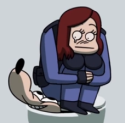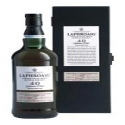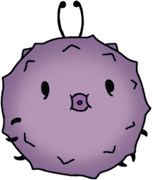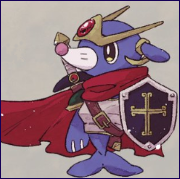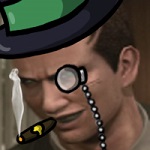|
Kitchner posted:If you enjoy playing a game where the DM doesn't need to change anything, and they can basically play a tabletop game against the players with the full intention to "win" the combat (presumably by killing the party, which I don't class as a win personally) then go for it. This system in't designed like that though, it's specifically designed for the DM to change some things, fudge some more things, and make stuff up on the fly if needed. If you don't like that then fine, play a different game which can be played DM vs the Players or whatever which apparently many of you do. You're literally arguing that Wizards designed this game poorly on purpose so that DMs could clean up after them. Even if that does somehow make sense, why is that a good thing? Please tell me a single good thing about having to readjust a trap's damage from d8 to d6 just so it doesn't unfairly kill my rogue 1/8 of the time because the design team couldn't be arsed to consider the average rogue HP at level 1. Every RPG in existence lets the DM 'change some things' and 'make stuff up on the fly'. Welcome to RPGs. The problem is when a game makes you do so.
|
|
|
|

|
| # ? May 14, 2024 15:27 |
|
With the new Next thread, is this just officially the D&D chat tread now? Re: Westmarches style game. A group I played in ran something like it based on the Fallcrest/Nentir Vale mini setting. It worked out well but in retrospect there were a few things we could have done better.
|
|
|
|
wallawallawingwang posted:With the new Next thread, is this just officially the D&D chat tread now? We have a new Next thread in what seems like an ill-fated attempt to get away from the people in this thread.
|
|
|
|
Tunicate posted:The problem is that Team PC intends to survive. Team Monster has effectively unlimited numbers, and don't care if they die. The result of suicidal beelining to the wizard, if the players make good decisions, should be that the battle is over quicker with fewer player losses. If the rules do not support a way for players to make suicide bombing the wizard a bad idea, then the rules are not good at tactical combat. If, in Strike! a defender starts the fighting by hitting and then marking a level 2 Striker monster, that monster will die if it walks away and hits someone else- doing so will provoke 6 damage of automatic opportunity damage. It has to charge to survive its attack (giving up the opportunity to use one of its special abilities) and if the players positioned properly that is not possible. That's the whole point- what you described in your post is a design obstacle, but it can be overcome by giving players the ability to limit monster options. 5e makes no attempt to do that, they expect DMs to limit their own options arbitrarily. 30.5 Days fucked around with this message at 23:26 on Feb 9, 2015 |
|
|
|
30.5 Days posted:The result of suicidal beelining to the wizard, if the players make good decisions, should be that the battle is over quicker with fewer player losses. If the rules do not support a way for players to make suicide bombing the wizard a bad idea, then the rules are not good at tactical combat. It means that Team Monster loses more quickly, yeah. That's the point - they aren't playing to win, they're playing to maximize the losses on the party's side. To a certain type of bad GM, it's far preferable to have Bob the wizard dead and all the orcs dead in round 1, instead of having the orcs get the whole party down to half health (spending most of their dailies), but still losing the battle in round five. Or a bunch of kobolds that spend all their actions trying to steal the party's potions, and immediately smash them on the ground. It works out poorly for the kobolds, but it screws the party over, and if the party LOSES, then obviously the gm WINS. Tunicate fucked around with this message at 23:40 on Feb 9, 2015 |
|
|
|
IT BEGINS posted:You're literally arguing that Wizards designed this game poorly on purpose so that DMs could clean up after them. Even if that does somehow make sense, why is that a good thing? Please tell me a single good thing about having to readjust a trap's damage from d8 to d6 just so it doesn't unfairly kill my rogue 1/8 of the time because the design team couldn't be arsed to consider the average rogue HP at level 1. Is this "DM Empowerment"?
|
|
|
|
Kitchner posted:How about if some guy is fighting one orc, and I get that orc to disengage and move back, while another, fresh, orc then charges forward and attacks. Is that something Orcs do? I don't feel like it is, but how can you stop me? If that's something that the game designer didn't intend the orc to be good at, and the monster description states or implies that the orc is bad at it, and the orc is actually good at it, then guess what? The rules for the orc are badly written. Kitchner posted:Even if it was some how, it doesn't solve the problem that the DM can just say "OK well all the Orcs attack the healer straight away, barrelling everyone else out of the way". Yeah I could probably think of some reason why in some single instance they do this, but it's not going to be a good explanation. Please tell me what games you've actually played, because in a well written game where the healer can't deal with this situation by themselves, the players, as a group, should have ways of stopping this from happening. If I can wipe the party first time every time by mobbing one PC and there's nothing they can do to stop it, then that's a problem with the system. Kitchner posted:There's no rule set in the world that will stop people playing monsters "wrong" without being so prohibitive that you can't play anything else. Nobody has said that the system should force the DM to play the monsters a certain way. That's something you made up because it's easier to argue against than what people are actually saying. I don't want the game to MAKE the DM play certain opponents a certain way. I want the game to show that <monsters> are <trait> by making them strong when they're played that way and crap when they're not played that way. Kitchner posted:I don't accept you can ever write a series of rules for any creature where someone who is "playing to win the fight" as he put it, can't pull off some bullshit. The more you blame "bad rules" for this poo poo the more you are basically forgiving bad DMs instead of saying "Yeah you know what, sounds like your group needs to talk to that guy". With a well written adventure/encounter design system, a fight won't be unfair. With well designed monsters, you should have a fair idea of what they're good at and what they're bad at. With a well designed combat system, both sides should be able to go all out and the fights should usually fall within the win/loss range the designers expected. If those rules are followed and the second of 8 fights is about to kill a PC or wipe the party unless a number is fudged, that's a problem with the system. If the DM chooses to ignore those rules, then yes, that's a problem with the DM. Kitchner posted:If you enjoy playing a game where the DM doesn't need to change anything, and they can basically play a tabletop game against the players with the full intention to "win" the combat (presumably by killing the party, which I don't class as a win personally) then go for it. This system in't designed like that though, it's specifically designed for the DM to change some things, fudge some more things, and make stuff up on the fly if needed. If you don't like that then fine, play a different game which can be played DM vs the Players or whatever which apparently many of you do. Do you actually believe the intent of the designers of this game was to make a system which doesn't work as intended and therefore requires on-the-fly adjustments and fixes? Do you think that's a good design goal? Why? Elector_Nerdlingen fucked around with this message at 23:47 on Feb 9, 2015 |
|
|
|
Tunicate posted:It means that Team Monster loses more quickly, yeah. That's the point - they aren't playing to win, they're playing to maximize the losses on the party's side. You missed the part where I said "with fewer player losses" and then explained how that worked.
|
|
|
|
I can safely say I have not played with a group that approved of dice-fudging - even "roll that d20 again" or "let's call that 7 an 8 instead" style fudging - since high school. It doesn't matter if it's in the players' favor or not. Adjusting the random number generator on the fly to suit the 'needs' of the story ('needs' being 'so the campaign doesn't end' and 'so a mechanically dull character feels relevant') just brings to light the utter pointlessness of the whole exercise. In a system that has a level of granularity that demands a qualitative difference between d6 and d8 damage, or which an entire class's claim to fame is a +1 or +2 under certain circumstances, having the DM hand you a victory smacks of ennui.
|
|
|
|
Mendrian posted:I can safely say I have not played with a group that approved of dice-fudging - even "roll that d20 again" or "let's call that 7 an 8 instead" style fudging - since high school. It doesn't matter if it's in the players' favor or not. Adjusting the random number generator on the fly to suit the 'needs' of the story ('needs' being 'so the campaign doesn't end' and 'so a mechanically dull character feels relevant') just brings to light the utter pointlessness of the whole exercise. In a system that has a level of granularity that demands a qualitative difference between d6 and d8 damage, or which an entire class's claim to fame is a +1 or +2 under certain circumstances, having the DM hand you a victory smacks of ennui. That is the dark secret of D&D; all of that stuff is just a smokescreen to make you think it matters. It's why spells that set the narrative are so powerful, and why you can't balance the system on the guy who has a lot of numbers and the guy who gets to make meaningful choices. It's also why you need to create game mechanics for narratively telling a story if the rest of the game is also filled with mechanics. It's why skills need mechanics to describe what they do. It's the reason you are paying a pro $150 for a make believe elf game. And if you feel roleplaying and narrative control don't need mechanics (despite the huge plethora of awesome games based on the opposite idea), what, exactly, did you spend $150 on? A bad combat system? A janky class system? The reason the game is fun is the roleplaying. The fact that there are no comprehensive mechanics, and those that exist boil down to "DM's Call" for a shared narrative experience, AKA roleplaying, should be a big indicator of how big a step backwards was taken with D&D Next. Laphroaig fucked around with this message at 00:29 on Feb 10, 2015 |
|
|
|
Serious question since I never really played 4e: how does it deal with the aforementioned kobolds all focus firing the wizard, or every orc charging the healer? Marking mechanics seem like they'd hasten the healers death.
|
|
|
|
mastershakeman posted:Serious question since I never really played 4e: how does it deal with the aforementioned kobolds all focus firing the wizard, or every orc charging the healer? Marking mechanics seem like they'd hasten the healers death. By giving the players more tools. Forced movement, area slows, and one dude who could hop into the middle and ruin your day if you ignored him. The big problem with 4e was too MANY tools. You had so many ways to react to monster aggression and those reactions took time to resolve. You had people freeze up on their turns because they had too many choices. And to be frank, if you knew what you were doing, it was very hard at high levels to challenge good players because there were so many available tools to tuck monsters into a tight little knot, AOE them, and ruin their day if they dared to leave the AOE. It was a hell of a lot of fun, though (I know, I know), even playing as the DM, and a 5th edition that worked on the real problems with 4th rather than the imagined ones would have been a great game.
|
|
|
|
mastershakeman posted:Serious question since I never really played 4e: how does it deal with the aforementioned kobolds all focus firing the wizard, or every orc charging the healer? Marking mechanics seem like they'd hasten the healers death. For one thing, every PC actually gets more battlefield-control options than blocking off one square and hoping the DM feels like playing stupid. Opportunity attacks are actually worth a drat. And if Marked kobolds try to go after the healer, the defender gets to gently caress them up.
|
|
|
|
mastershakeman posted:Serious question since I never really played 4e: how does it deal with the aforementioned kobolds all focus firing the wizard, or every orc charging the healer? Marking mechanics seem like they'd hasten the healers death. Why would marking hasten someone's death? The mechanic basically says "if you try to move/attack my friend/etc I get to push you around/damage you/make life hell," which puts the monster in a situation where they must choose to attack the Defender or trigger the Defender's mark bonus and risk not getting to move or dying or just having a bad time all together. It also deals with that situation by just makign insta-gibbing not really a thing. I've been crit by solo boss monsters and only lost ~1/3 of my health as a Striker. That of course sucks because it means I should probably be healed sooner rather than later and the party's leader has a finite amount of healing, but it isn't going to instantly take me out. Additionally I have options to mitigate damage, and so do controllers/leaders if they so choose, in the form of reaction and interrupt abilities.
|
|
|
|
mastershakeman posted:Serious question since I never really played 4e: how does it deal with the aforementioned kobolds all focus firing the wizard, or every orc charging the healer? Marking mechanics seem like they'd hasten the healers death. I was the party cleric in my 4e group, and let me tell you, those marking mechanics, in addition to abilities that defenders could use meant that 8/10 times, those orcs and kobolds couldn't focus me even when their short-lived lives depended on it.
|
|
|
|
mastershakeman posted:Serious question since I never really played 4e: how does it deal with the aforementioned kobolds all focus firing the wizard, or every orc charging the healer? Marking mechanics seem like they'd hasten the healers death. Marks can make it so that if minions even try to get past a defender (tanky area denial dude) they die. Controllers (wizards and some other classes) can cordon off areas from enemies, shove them around, restrict movement, etc. Leaders (clerics, warlords) can buff allies so they take less damage or plop down emergency healing if needed. In addition, everyone has a self heal, and everyone has enough hp to survive a few hits from all but the most powerful critters (and kobolds certainly aren't the most powerful critters).
|
|
|
|
mastershakeman posted:Serious question since I never really played 4e: how does it deal with the aforementioned kobolds all focus firing the wizard, or every orc charging the healer? Marking mechanics seem like they'd hasten the healers death. The Defender role gives characters a strong set of tools to allow such characters the ability to actively defend other party members by giving monsters hard choices about who to attack. Everybody in 4E gets a 1/fight Second Wind as a panic button. It's not ideal to have to use it since it eats your standard action unless you're a dwarf, but it exists as an option. The math that goes into 4Es combat system is much less rocket taggy than Next's which both allows GMs the freedom to not have to pull punches but also allows players the opportunity to react to unfolding situations as the fight progresses rather than immediately getting spiked.
|
|
|
|
Dirk the Average posted:Marks can make it so that if minions even try to get past a defender (tanky area denial dude) they die. Controllers (wizards and some other classes) can cordon off areas from enemies, shove them around, restrict movement, etc. Leaders (clerics, warlords) can buff allies so they take less damage or plop down emergency healing if needed. In addition, everyone has a self heal, and everyone has enough hp to survive a few hits from all but the most powerful critters (and kobolds certainly aren't the most powerful critters). Don't forget that leaders also have many abilities that grant move actions, so someone can shift away from an enemy before their turn comes up, allowing them to get distance and rain fire on their initiative.
|
|
|
|
mastershakeman posted:Serious question since I never really played 4e: how does it deal with the aforementioned kobolds all focus firing the wizard, or every orc charging the healer? Marking mechanics seem like they'd hasten the healers death. Yo, what about the marks gave you the impression that they'd kill the healer?
|
|
|
|
mastershakeman posted:Serious question since I never really played 4e: how does it deal with the aforementioned kobolds all focus firing the wizard, or every orc charging the healer? Marking mechanics seem like they'd hasten the healers death. Nothing does enough damage to kill a player in a single turn. If the kobolds bum rush the wizard they are almost certainly going to move past the defender who is going to clobber at least one despite their shifting prowess, and now despite having rushed into the wizard and spent all they had to kill him hes probably not dead (because again, you have enough health to last at least one round of this) the party all turn around and kill the now flanked to hell kobold group. The leader heals the the wizard as a minor action and still attacks and the wizard has their second wind to use if they are desperate. The striker is going to happy cut the kobolds to pieces now they are in a bad position. This is just assuming all your characters a plain old 'i attack it' types at level 1. You could have a warlock who is teleporting targets around or is turning stealth mode so hes safe from being exposed or someone is dropping aoe movement impairing effects or the fighter is pulling a scorpion and pulling the wizard out of the melee fray. Everyone has all sorts of abilities to use to handle the situation.
|
|
|
|
What about kobolds with slings?
|
|
|
|
Opportunity attacks/actions are also an at-will action you can take once per other creature's turn, so mobs can't all rush past the tank with only one being hit. That's one of the big things I noticed in 5th. One reaction is never enough.
|
|
|
|
kingcom posted:Nothing does enough damage to kill a player in a single turn. A MM3 solo that action points with a multi-attack power (like a Dragon) that stunned the party and won initiative can actually focus and nuke a player off the table (negative bloodied dead). This happened in a 4E game I was running and it was so out of the ordinary that I was shocked. To be fair the player in question had crap AC and I rolled well, but the major thing was being stunned robbed the players of their reactions. quote:Kobolds with Slings 4E encounter math means that you won't kill a player with focus firing unless you build an encounter to be deadly. Even then, a player might have a plethora of cheat-death abilities. AKA if it occurs, its because you built the encounter to be a player-killer. Players could also just win initiative and nuke the Kobolds off the table. Laphroaig fucked around with this message at 01:09 on Feb 10, 2015 |
|
|
Tunicate posted:What about kobolds with slings? Or if they're minions they're doing even less damage, and the wizard will blow them all away on his turn. Also, if the squishy actually is a wizard, Shield is a badass level 2 utility power to hit as an emergency button, and basically made for situations like this since it lasts a whole turn. And it's been a while, but I'm pretty sure standing behind an ally gives you cover.
|
|
|
|
|
Also there are a number of leader reaction heals, reaction movement powers that trigger when you take damage, racial powers that do all sorts of poo poo. God knows what madness you can pull with magic items. 4e got really, really convoluted at times.
|
|
|
|
Tunicate posted:What about kobolds with slings? Yea this is what I meant by focus firing, slings or bows. Should have specified. And wrt marking orcs, if they do more damage when bloodied and on death, it seems they'd kill the healer even faster unless they're immobilized. I have no idea if charge bypasses an immobilizing aoe. I'm also specifically talking about low level where you'd see orcs and kobolds (who should be ambushing) The answers seem to be that ranged simply doesn't do enough damage and melee gets snared.
|
|
|
|
30.5 Days posted:The big problem with 4e was too MANY tools. Something that's frequently overlooked is that this can be avoided by playing a character from first level. It's easy to look at a 12th level 4e character and think it's piloting the space shuttle, but if you're playing as intended you're thoroughly familiar with the ins-and-outs of all but your most recently acquired ability. A lot of people's first experience with 4e was diving into this at the deep end ("because we're good at D&D!") and concluding that the game was some kind of fifteen-dimensional adventurer simulator that no human could master. So now your character's options are paired down across the board, based almost entirely on misconceptions and misinformation about how many options a player could handle.
|
|
|
|
Tunicate posted:What about kobolds with slings? They could focus fire and be really annoying, but let's put some numbers on the table so we can compare 4e and 5e. In 4e, a first level Fighter has (15 + Constitution score) hit points, so probably between 25 and 30 or so. A Wizard has (10 + Constitution score) hit points, so he's only like 5 hp behind the Fighter. Which is a difference but not a crippling one. In 5e the Fighter might have 10+ hp and the Wizard 6+. So the 5e Wizard has nearly half of what the Fighter got. Armor Class is in a similar situation. A 4e Wizard can use either their Dex or Intelligence mod to determine their AC, but a 5e one can only use Dex. All in all a 4e Wizard has sufficient defenses to withstand a few attacks. Focus firing kobolds can make things painful but the Cleric/Warlord/Bard/whatever should have enough healing to keep things under control. And then your melee types interpose themselves and provide cover, etc. Simply put, 4e can handle this. You can play the kobolds intelligently and use reasonable tactics and the game will work as intended. From what I've seen of 5e... not so much. Focus firing a Wizard just means you're likely to have a dead wizard.
|
|
|
|
moths posted:Something that's frequently overlooked is that this can be avoided by playing a character from first level. I sort of agree but I've seen characters plaid from level 1 up to 20+ and they still end up confusing the players. Some powers and feats are a bit too fiddly, especially with interrupts that wreck the flow of the game. The core math and concepts of the game are sound but the devil is in some of the details. (Oh and there's way too many feats.)
|
|
|
|
One nice thing about 4e was the retraining - if you ended up with something you just didn't "get," it was trivial to swap it out for something more your speed.
|
|
|
|
Tunicate posted:What about kobolds with slings? Kobolds with slings tend to be the type that are prepping ambushes rather than killing things, their damage is pretty lackluster but they have abilities like glue shot that immobilizes targets and another shot (smoke i think) that gives a -2 penalty to attack rolls. Their offensive power is fire bombs which set you on fire giving you a damage over time problem as opposed to high nuke abilities.
|
|
|
|
I guess the question is is there a low level enemy that has a high damage alpha strike, ranged or not? Because if the highest alpha strike isn't enough to kill the weakest party member first round out of an ambush, you're all right that the dm can be ultra aggressive.
|
|
|
|
I'm wondering if anyone has examples of really interesting dungeons/ campaigns/ NPCs that they'd like to share. I'm fairly new to D&D and I feel that hearing about other peoples great games is a fun way to get inspiration. I recently heard about one where the players were fighting through a pyramid after some vague artifact that, when they got to its holding room, was radiating necrotic energy like nuclear waste. After sacrificing many charmed lackeys and suffering many points of damage, they eventually figured out how to put it into a heavily blessed lead chest, carted it off and sold it to the kingdoms wizards that wanted to use it to power the capital with magic energy like a generator. The artifact wound up being the cursed mummified heart of a gnarly necromancer who was using it as his phylactery and every corpse in the city came to life when the power turned on. So then they had to fight that jerk.
|
|
|
|
mastershakeman posted:I guess the question is is there a low level enemy that has a high damage alpha strike, ranged or not? Because if the highest alpha strike isn't enough to kill the weakest party member first round out of an ambush, you're all right that the dm can be ultra aggressive. There are definitely high damage alpha strike characters but never enough to kill a player off the bat unless the enemy is either much much higher level than the players or an extremely specific set of circumstances all trigger off together but this is an example of it happening: Laphroaig posted:A MM3 solo that action points with a multi-attack power (like a Dragon) that stunned the party and won initiative can actually focus and nuke a player off the table (negative bloodied dead). This happened in a 4E game I was running and it was so out of the ordinary that I was shocked. To be fair the player in question had crap AC and I rolled well, but the major thing was being stunned robbed the players of their reactions. This is essentially a monster the whole party are supposed to take on its own, it not only won initiative, it has multiple attacks, stunned the target preventing them from reacting, and probably had some legendary abilities to give even more juice AND it was attacking a low AC character landing good rolls. Thats one hell of a combo to knock someone out. Not to mention as a solo its almost certainly a big boss fight so killing someone at the big dramatic moment at the end of the campaign doesn't seem that bad. This was also something that is insanely out of the ordinary.
|
|
|
|
mastershakeman posted:I guess the question is is there a low level enemy that has a high damage alpha strike, ranged or not? Because if the highest alpha strike isn't enough to kill the weakest party member first round out of an ambush, you're all right that the dm can be ultra aggressive. Infamously Needlefang Drakes used to be absolutely brutal to low level 4E characters but I believe that they got their damage values adjusted.
|
|
|
|
In 4e it's easy to temporarily remove a PC's threat with conditions like stun, blind, or immobilize, but very hard to outright kill them unless you focus every single monster on them. And even then, the other PCs will be able to punish that sort of tactic quickly.
|
|
|
|
Tunicate posted:It means that Team Monster loses more quickly, yeah. That's the point - they aren't playing to win, they're playing to maximize the losses on the party's side. Targeting the wizard is a tactic that is playing to win instead of just maximize losses, though? They'll probably die en masse, and faster to boot, if there is a wizard wizarding at them, so the wizard is an obvious priority target. If they attack a guy and the cleric heals them, they aren't that dumb, they are going to recognize that pounding on a dude that is being healed is not effective, and try to take out the guy healing them so they actually have a chance to kill someone. Having humanoids ignore this in order to just attack the guy in armor makes you play them like idiots.
|
|
|
|
Kai Tave posted:Infamously Needlefang Drakes used to be absolutely brutal to low level 4E characters but I believe that they got their damage values adjusted. Yeah, it was a really dangerous monster and it was supposed to be suitable for low level PCs. It did 1d10+4 damage, or 2d10+4 against a prone target. It had the ability Pull Down, which knocked a target prone as a minor at-wll action at +7 vs Fort. So it could knock you down pretty easily and near-double its damage. The errata changed damage to 1d6+2 and 2d6+2, and change Pull Down to minor 1/round and +3 vs Fort, which was much more reasonable.
|
|
|
|
mastershakeman posted:Yea this is what I meant by focus firing, slings or bows. Should have specified. A kobold slinger is a level 1 artillery with a +8 attack that does an average of 8.5 damage. So I guess the idea is you generate a "hard" encounter that consists of 5 slingers for a 4 character party. They win the initiative over all 5 players, they move from ambush into range of the wizard with something like 22-24 hitpoints and 13 AC, and score an average of 32 damage, therefore taking him out. So here's the problems with that: - Kobolds have initiative +3, so this circumstance is unlikely to be executed. Most likely, the ranger goes before the kobolds, ends one, and one other guy goes. - In 4E, rules as written, you are not supposed to continue attacking players once they are unconscious. DMG 4E posted:Don't hit people when they're down. When a character falls unconscious, monsters turn their attention to enemies who are still up and fighting. Monsters don't usually intentionally deal damage to fallen foes. WIth the 4E death rules, this means that even if the wizard is an ashy smear on the ground, he's probably not dead, he's just useless. The kobolds then try to focus the ranger the following turn, are unable to do so since the other players have gone, and then die as the cleric gets the wizard back up. I actually don't like this rule very much, I feel like a better solution would be incorporating fail forward, giving players plot armor when they're "dead" to allow monsters to remove them from the board proactively and force the other players to deal with their new strategic position. But this is an example of what people are talking about- 4th had the right trajectory away from 3rd edition mechanics but was still not where it needed to be, whereas 5th looped back around. Last I checked coup de gras was a full-round action, though, and instant death is negative bloodied so I don't think the monsters have the power to kill him this turn even if the DM wants to do it.
|
|
|
|

|
| # ? May 14, 2024 15:27 |
|
Mormon Star Wars posted:Having humanoids ignore this in order to just attack the guy in armor makes you play them like idiots. Which is something 4e went a long way towards fixing via all the methods the others were just talking about. The DM could absolutely attempt to go hard on the healer or caster and the palyers won't have to worry except under specific circumstances like Laphroaig posted:A MM3 solo that action points with a multi-attack power (like a Dragon) that stunned the party and won initiative can actually focus and nuke a player off the table (negative bloodied dead). This happened in a 4E game I was running and it was so out of the ordinary that I was shocked. To be fair the player in question had crap AC and I rolled well, but the major thing was being stunned robbed the players of their reactions.
|
|
|



